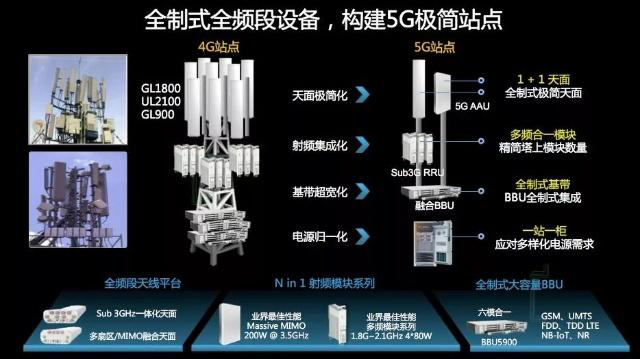NewsNews information
Why is 5G base station so simple?
Originally thought that the future network 2/3/4 / 5G coexisted, Unicom's existing network has GUL three standard and 900M / 1800M / 2100M three frequency bands, and then introduce 5G new spectrum and new modules, the base station site will be more complicated and will increase the site Energy cost and tower rental cost.
But this is not the case.
In actual deployment, 5G equipment supports full-system large-capacity BBU product solutions, N in 1 multi-standard fusion RF and full-band antennas, which can achieve site simplicity, reduce energy consumption and tower rent. The structure is as follows:

1 + 1 Minimalist Sky: 1P (Passive, passive) multi-port sky surface is included in the Sub 3G inventory sky surface, 1A (Active) 5G 3D MIMO independent sky surface.
Multi-frequency integration module: through 1.8G + 2.1G dual-frequency 4T4R and other multi-frequency modules, the RF modules on the tower are reduced by 1 when 2, supporting 1 + 1 minimalist sky surface;
Full-standard baseband: large-capacity full-standard BBU, single BBU supports six modes in one;
One station, one cabinet: Through intelligent outdoor cabinets, one station, one cabinet and one machine room can be realized, saving machine room resource investment.
Full-standard full-band equipment and 1 + 1 minimalist sky, greatly simplifying the complexity brought by 2/3/4 / 5G co-site, which can achieve no or little increase of tower rent in the 5G era, reducing operator operating costs .
Next, answer two other questions:
What the is the blade power supply?
What is the iron-lithium battery pack?
With 5G deployment, base station power supply support faces three major challenges:
First, it is difficult to expand the city power. There are many city power expansion approvals, long periods, and high costs. At the same time, according to the previous design specifications, the calculation of power application quota or power redundancy quota is based on the peak power consumption of the base station. The amount will be much less, we need to apply for more city power quota, the cost will be higher.
Second, most of the switching power supply (DC power supply) capacity in the equipment room is close to saturation, which requires expansion or new construction. If the new construction is constructed according to the traditional scheme, it will bring about problems such as insufficient space in the computer room and insufficient load bearing (mainly referring to lead-acid batteries).
The third is that the existing power supply limits 5G deployment. The power consumption of 5G wireless main equipment (especially AAU) has increased. The current DC power supply standard is -48V, with low voltage, large current, and short transmission distance, resulting in reduced power availability (using -48V for AAU power supply, power supply distance less than 40 meters @ 6 square cable, and the actual AAU power supply distance is 70% to 40-70 meters).
To this end, 5G needs to introduce new communication energy solutions:
1. Introduce iron-lithium battery pack, cut the peak and reduce the cost of electricity
In view of the difficulty in expanding the capacity of the city power, the power consumption of the base station in the 5G era will be considered according to the average power consumption of the base station. At the peak, the power is discharged through the city power + lithium iron battery to ensure the power consumption of the base station. Minimize the amount of utility power re-application, speed up deployment and reduce the cost of electricity.
At the same time, compared with the traditional lead-acid battery, the iron-lithium battery pack is lighter in weight, faster in deployment, and has a very small amount of engineering. It solves the space and load limitation of the computer room and is isolated from the existing power supply scheme without affecting each other.
In addition, the 5G energy solution uses -57V output, compared with -48V power supply, under the same conditions, the line loss is reduced by 60%, which further reduces the city's power demand.
2. Introduce the blade power supply scheme, no indoor modification, and outdoor power supply on demand
In order to increase the power consumption of 5G wireless main equipment, indoor blade power solution (Indoor Blade) is used indoors, sharing the rack with the main equipment to meet the power requirements of 5G equipment (including BBU and AAU). The blade power solution has the advantages of light weight, small footprint, and easy deployment. It is isolated from the existing power solutions and does not affect each other. For outdoor AAU remote stations, the DPS (Distributed Power Supply) solution is used to provide power to the nearest AAU. The direct transfer module and the lithium battery can be embedded as required, and installed on the same pole with AAU to achieve zero footprint, Rapid deployment solves the problems of traditional property (outdoor cabinets, embedded power supply and batteries) that are difficult to coordinate with the property, difficult to enter, and high rent.
3. Moderate boost to improve power availability
In response to the problem that the existing -48V power supply limits the deployment distance of 5G AAU, the 5G energy solution uses a -57V constant voltage power supply, the distance of 6 square cables can be up to 100 meters, and the line loss is reduced by 60%. Power availability is close to 100%.
...
(To be continued)